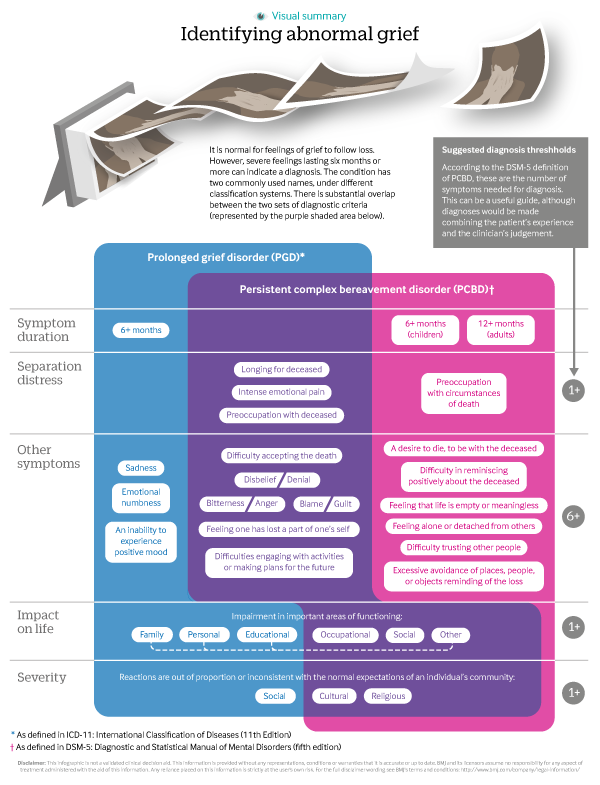Disturbed grief: prolonged grief disorder and persistent complex bereavement disorder
BMJ 2017; 357 doi: https://doi.org/10.1136/bmj.j2016 (Published 18 May 2017) Cite this as: BMJ 2017;357:j2016
Infographic available
Click here for a visual overview of symptoms that can indicate abnormal grief.
- Paul A Boelen, professor of clinical psychology1 2,
- Geert E Smid, psychiatrist and senior researcher2
- 1Department of Clinical Psychology, Utrecht University, Netherlands
- 2Arq Psychotrauma Expert Group, Diemen, Netherlands
- Correspondence to P A Boelen P.A.Boelen{at}uu.nl
- Accepted 28 March 2017
PRIYA SUNDRAM
What you need to know
-
When confronted with the death of a loved one, most people experience transient rather than persistent distress, and do not develop a mental health condition.
-
Bereavement, specifically the sudden, unexpected death of a loved one is associated with an elevated risk for multiple psychiatric disorders.
-
Consider prolonged grief disorder (PGD) in people with ongoing separation distress beyond the first six to 12 months of bereavement.
-
PGD occurs in approximately 10% of bereaved individuals, with an increased risk following the death of a partner or child and loss to unnatural or violent circumstances, and among people vulnerable to mental health conditions.
-
Psychological treatments addressing the pain and consequences associated with the irreversibility of the separation can be effective.
-
Emerging evidence provides limited support for pharmacological interventions.
Each individual’s grief process is unique. The concept of stages of grief occurring in a specific order is a popular, yet inadequate representation of what grieving people go through.1 Traditional models developed to understand grief therefore often unhelpfully suggest that all bereaved individual do, and even should, follow the same process towards recovery from loss. The newer grief task model2 offers a more neutral framework to describe normal and disturbed grief. The model proposes that normal grief is the successful achievement of certain “grief tasks,” whereas complications in managing these tasks might indicate disturbed grief. There is no recommended or specific order in which to achieve these tasks. Grief tasks include: to accept the reality of the loss; to process the associated pain; to adjust to a world without the deceased; and to find an enduring connection with the deceased in the midst of embarking on a new life. The model also describes challenges faced following losses other than bereavement (Box ‘Grief following events other than bereavement’). Doctors from any specialty can identify …
Log in
Log in using your username and password
Log in through your institution
Subscribe from £173 *
Subscribe and get access to all BMJ articles, and much more.
* For online subscription
Access this article for 1 day for:
£38 / $45 / €42 (excludes VAT)
You can download a PDF version for your personal record.
